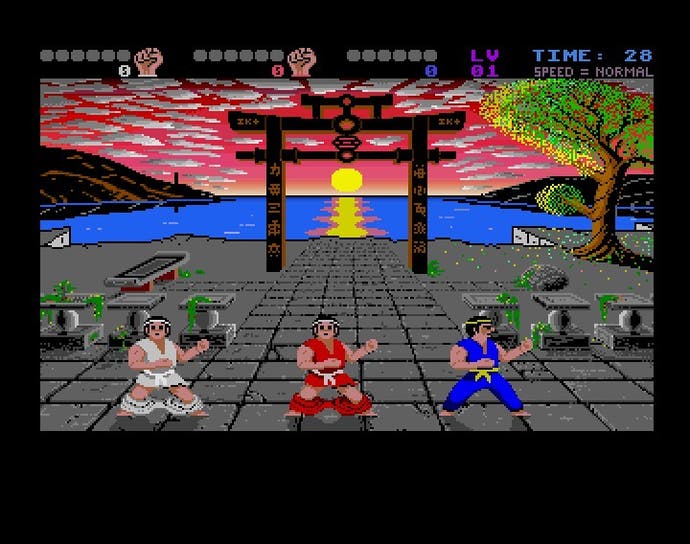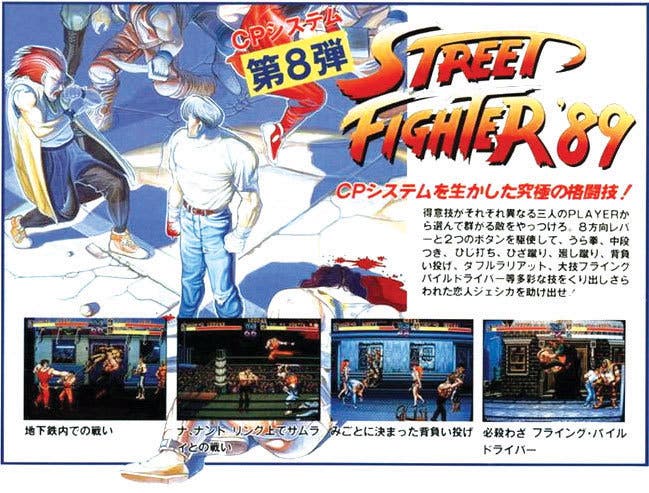The Tao of Beat-'em-ups
Part 2: A fight is not won by one punch or kick. Fighting from '85 to '93.
"Use only that which works, and take it from any place you can find it." - Bruce Lee
There was a palpable sensation of change permeating the arcades and game shelves in 1985. Fighting games, of all varieties, were a proven entity and we waited impatiently for the digital realisation of kung fu cinema and cheeseball action flicks. Once the lull turned into the torrential bone-storm of videogame violence we so desperately anticipated, the industry would never be the same.
Arcades had transformed from family amusement centres into ruthless gladiatorial arenas, while home systems saw an influx of peripherals designed to accommodate the untamed nature of the new fighting gamer. Joysticks boasted superior strength, extra buttons and tactile grips, and games veered tensely away from delicate keyboard controls lest the fury of a fighting game destroy the entire computer.
The genre was blue hot; a pinnacle not only of hard and fast gameplay, but of technical achievement. Rendering the human form onscreen was a hugely significant milestone, and its influence began to spread across the entire gaming sphere. Given leave to experiment in more mature, less socially responsible themes by the fighting genre's public acceptance, shoot-'em-ups adopted a personal, close-quarters approach to destruction while platformers took a hands-on, brutal tactic when dispatching enemies.
Behind the scenes, developers were acutely aware of the gaming public's need for genre expansion, and everyone from cassette-based budget labels to the industry leading coin-op manufacturers forged ahead with a new season of beat-'em-up titles. As it was, this next leg in the race would be won by the company who first helped pioneer fighting games; cross-breeding the one-on-one tournament with the multiple adversaries and unexplored possibilities of the scrolling beat-'em-up.
"I dare not say that I have reached a state of achievement. I'm still learning, for learning is boundless." - Bruce Lee

The eponymous, treacherous setting for most every scrolling fighter - ambiguously referred to as "The Street" - began with veteran fighting game developer Technos, in its 1986 groundbreaking beat-'em-up hybrid, Nekketsu Kou-ha: Kunio Kun (translating as Kunio: The Hot Blooded Bad Boy). Stripping away the sporting, honourable nature of Karate Champ, the action was turned out onto Tokyo's merciless Street, where gangs felt the raw-knuckled fury of a brother scorned.
Regionalised that same year as Renegade, the small, scrolling levels took the rough pattern of Kung Fu Master's multiple assailants and cultivated it. While the Japanese version focused on schoolyard squabbles, the Western adaptation provided a far more severe premise. A nameless rebel took revenge on the underworld of an entire city for the kidnapping of his girlfriend - remorseless and unquestioning, the Renegade made the criminal class pay. He was one of them, but for a vague moral code, and placing gamers in the shoes of a character more aggressive and sadistic than the enemy was a stroke of industry-changing genius, and the principled gameplay of the tournament fighter was suddenly cast in a pallid, anaemic light.
But until this new concept trickled down the evolutionary ladder and into our homes, the tournament fighter still reigned supreme. In many ways, the home systems carried the torch for the one-on-one fighter longer and further than the arcades ever managed. While Renegade brutalised the coin-ops, Archer MacLean was picking up where Way of the Exploding Fist left off on the domestic market.

The C64 fighter was a phenomenal hit and propelled the machine into fighting game history. A degree of controversy courted the game, as Data East attacked System 3 for similarities between Karate Champ and International Karate, but gamers cared nothing for legal blood-sucking - all that was important was the magnificent, slick gameplay and awesome sound at the centre of MacLean's celebrated game. Besides which, there was no home version of Karate Champ worth pointing a joystick at, so no amount of court room solicitation was going to pry the new breed of beat-'em-up fanatic from a game like International Karate. The only alternative litigious developers had was to create new and better games - not squabble over tedious copyright in some oak-panelled old-boy's club.
So while Data East and System 3 wasted time making their lawyers rich, Technos once again delivered an uncompromising back-elbow to the gaming industry in its spiritual successor to Renegade.
"Not failure, but low aim, is the crime. In great attempts it is glorious even to fail." - Bruce Lee
The graphics were a bit cartoony, the hardware a little underpowered, the levels a bit short and maybe it didn't even play all that well, but the breathtaking innovation at the core of Double Dragon made it an instant classic.
The outstanding two-player co-operative gameplay sanctified the scrolling beat-'em-up and ushered in the Golden Age of the fighting game in 1987. The arcades trembled beneath the resonant thud of 10,000 digital punches landing at once, and a torrent of scrolling beat-'em-ups flooded into the neon dojos.
